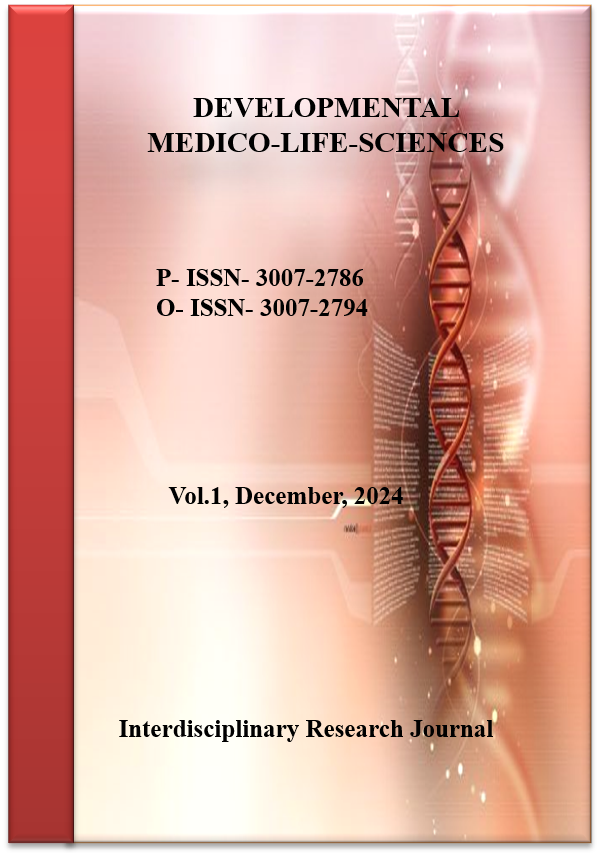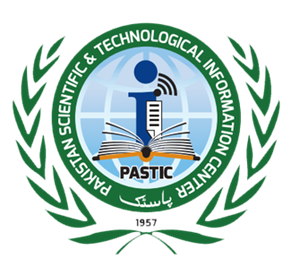Leishmania tarentolae Cell-Free System for Filamentous Protein Expression
Recombinant Protein Expression Using L. tarentolae
DOI:
https://doi.org/10.69750/dmls.01.010.079Keywords:
Expression system, Leishmania tarentolae, proteins of Toxoplasma gondii, SAG1, Cyclophilin 18Abstract
Background: In earlier studies, Leishmania tarentolae is known as an expression system due to its post-translational modification. SAG1 and Cyc18 proteins of T. gondii was evaluated for protection against toxoplasmosis. A surface glycoprotein of T. gondii, is a promoter of the immune response and previously studied for vaccine development during the infection. Cyc18 induces IL-12, which can drive Th1 and CD8+ T cell development when bound to CCR5, it rolled to adjuvant the immune response of T. gondii surface protein.
Objectives: This study was performed to evaluate the efficiency of SAG1 (Surface Antigen 1) and TgCyc18 (Cyclophilin 18) considered a a CCR5 chemochine for Toxoplasma gondii vaccine when expressed in L. tarentolae.
Methods: SAG1 and TgCyc18 genes were cloned and transfected into L. tarentolae. Protein expression and secretion were effectively validated by PCR, immunoblotting, enzyme activity, ELISA, and immunofluor. And features of SAG1 were evaluated mass spectrometry.
Results: Successful transfection of SAG1 and TgCyc18 plasmids and transfected into Leishmania tarentolae, and was confirmed by two steps of PCR. Current study verified that the culture supernatant included positive expression and secretion of the T.gondii protein (SAG1) into the media, indicated by acid phosphatase assay. The characteristics of the SAG1 protein were established using immunofluorescence, immunoblot, ELISA, and mass spectrometry.
Conclusion: This study confirms that L. tarentolae effectively can produces and secretes recombinant T. gondii proteins (SAG1 and TgCyc18), offering a potential platform for vaccine development against toxoplasmosis.
Downloads
References
Klatt S, Simpson L, Maslov DA, et al. Leishmania tarentolae: Taxonomic classification and its application as a promising biotechnological expression host. PLoS Negl Trop Dis. 2019;13:e0007424.
Taylor VM, Muñoz DL, Cedeño DL, et al. Leishmania tarentolae: Utility as an in vitro model for screening antileishmanial agents. Exp Parasitol. 2010;126:471–5.
Li J, Zheng ZW, Natarajan G, et al. First successful report of the in vitro life cycle of Chinese Leishmania: Conversion of amastigotes raised to 94%. Acta Parasitol. 2017;62:154–63.
Grebowski J, Studzian M, Bartosz G, et al. Leishmania tarentolae as a host for heterologous expression of human ABCB6 transporter. Biochim Biophys Acta Biomembr. 2016;1858:2617–24.
Akram J, Mojgan B, Bahram K, et al. Serum- and hemin-free medium for cultivation of Leishmania tarentolae for recombinant protein expression. Afr J Biotechnol. 2015;14:2130–4.
Burza S, Croft SL, Boelaert M. Leishmaniasis. Lancet. 2018;392:951–70.
Bolhassani A, Shirbaghaee Z, Agi E, et al. VLP production in Leishmania tarentolae: Expression and assembly of HPV16 L1. Protein Expr Purif. 2015;116:7–11.
Kalef DA. Recombinant filamentous acid phosphatase as a carrier for Toxoplasma gondii SAG1 expression in Leishmania tarentolae. J Parasit Dis. 2021;45:1135–44.
Hunter DJB, Bhumkar A, Giles N, et al. Instability explains batch variability in cell-free protein expression systems. Biotechnol Bioeng. 2018;115:1904–14.
Wiese M, Görcke I, Overath P. Expression and species-specific glycosylation of acid phosphatase in Leishmania major. Mol Biochem Parasitol. 1999;102:325–9.
Ilg T, Stierhof YD, Craik D, et al. Filamentous mucin-like proteophosphoglycan of Leishmania. J Biol Chem. 1996;271:21583–96.
Stierhof YD, Wiese M, Ilg T, et al. Structure of secreted acid phosphatase polymer of Leishmania mexicana. J Mol Biol. 1998;282:137–48.
Lekutis C, Ferguson DJP, Grigg ME, et al. Surface antigens of Toxoplasma gondii: Variants and functions. Int J Parasitol. 2001;31:1285–92.
He X, Grigg ME, Boothroyd JC, et al. Structure of surface antigen from Toxoplasma gondii SRS family. Nat Struct Biol. 2002;9:606–11.
Wang Y, Yin H. Research progress on SAG1 of Toxoplasma gondii. Parasites Vectors. 2014;7:180.
Abdizadeh R, Maraghi S, Ghadiri AA, et al. Cloning and expression of SAG1 gene using pVAX1 in CHO cells. Jundishapur J Microbiol. 2015;8:1–10.
Ibrahim HM, Nishimura M, Tanaka S, et al. Overproduction of cyclophilin-18 enhances parasite dissemination. BMC Microbiol. 2014;14:76.
Fachado A, Rodriguez A, Molina J, et al. Long-term immune response induced by genomic library vaccination of T. gondii. Infect Immun. 2003;71:5407–11.
Badirzadeh A, Montakhab-Yeganeh H, Miandoabi T. Arginase/NO pathway modulation using live Leishmania tarentolae. J Parasit Dis. 2021;45:65–71.
Fritsche C, Sitz M, Weiland N, et al. Growth behavior of Leishmania tarentolae as a recombinant expression system. J Basic Microbiol. 2007;47:384–93.
Wingfield PT. Protein precipitation using ammonium sulfate. Curr Protoc Protein Sci. 2016;1–10.
Wingfield P. Protein precipitation using ammonium sulfate. Curr Protoc Protein Sci. 2001;Appendix 3F.
Aydin S. History, principles, and types of ELISA with laboratory experience. Peptides. 2015;72:4–15.
Efstathiou A, Smirlis D. Leishmania protein kinases as molecular targets. Microorganisms. 2021;9:691. doi:10.3390/microorganisms9040691.
Shakarian AM, Joshi MB, Ghedin E, et al. Functional domains of surface membrane acid phosphatase in L. donovani. J Biol Chem. 2002;277:17994–1001.
Lai JY, Klatt S, Lim TS. Leishmania tarentolae as a platform for antibody expression. Crit Rev Biotechnol. 2019;39:380–94.
Raymond F, Boisvert S, Roy G, et al. Genome sequencing of L. tarentolae: Loss of intracellular stage genes. Nucleic Acids Res. 2012;40:1131–47.
Cantacessi C, Dantas-Torres F, Nolan MJ, et al. Leishmania genomics and transcriptomics: Past, present, future. Trends Parasitol. 2015;31:100–8.
Gehl J. Electroporation theory and methods for gene therapy and research. Acta Physiol Scand. 2003;177:437–47.
de Oliveira TA, da Silva W, da Rocha Torres N, et al. LEXSY Leishmania tarentolae expression system: A review. Process Biochem. 2019;87:164–73.
Sanchez-Garcia L, Martín L, Mangues R, et al. Recombinant pharmaceuticals from microbial cells: 2015 update. Microb Cell Fact. 2016;15:33.
Hartmann MWW, Breitling R. Suspension culture of protozoa. In: Industrial Scale Suspension Culture of Living Cells. Wiley; p. 294–347.
Kianmehr A, Mahrooz A, Oladnabi M, et al. Purification and characterization of recombinant darbepoetin alfa from L. tarentolae. Mol Biotechnol. 2016;58:566–72.
Basile G, Peticca M. Recombinant protein expression in Leishmania tarentolae. Mol Biotechnol. 2009;43:273–8.
Clayton CE. Genetic manipulation of kinetoplastida. Parasitol Today. 1999;15:372–8.
Teixeira SM. Gene expression control in Trypanosomatidae. Braz J Med Biol Res. 1998;31:1503–16.
Garg G, Singh K, Ali V. Proteomic analysis of secreted proteins of Leishmania. Biochim Biophys Acta Proteins Proteomics. 2018;1866:913–23.
Dorsey BM, Cass CL, Cedeño DL, et al. Electric field stimulation alters acid phosphatase release in L. tarentolae. Pathogens. 2018;7:77. doi:10.3390/pathogens7040077.
Koteshwara A, Philip NV, Aranjani JM, et al. Simple methods for detection and extraction of laminarinase. Sci Rep. 2021;11:2489.
Halliday C. Flagellum attachment zone role in Leishmania mexicana. Oxford Brookes University; 2021.
Nakayasu ES, Gritsenko M, Piehowski PD, et al. Best practices for MS-based protein biomarker discovery. Nat Protoc. 2021;16:3737–60.






















